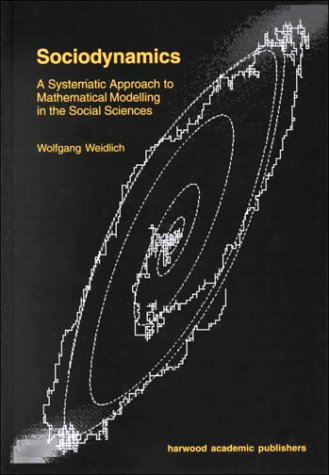Reviewed by
Glen Lesins
Department of Physics and Atmospheric Science
Dalhousie University
Halifax
Nova Scotia
Canada
B3H 3J5

Modelling of societal groups remains a great challenge, not for the lack of mathematical tools, but from the complexity of the system itself. The technical and intellectual problems in quantifying the interactions within societies are daunting. There is a belief that highly complex systems can be understood in terms of a manageable number of degrees of freedom. This holds out hope that insights about societies can be obtained from models and that perhaps even some predictive capabilities can be realized.
It is with this backdrop that I am pleased to see the text by Wolfgang Weidlich entitled "Sociodynamics: A systematic approach to mathematical modelling in the social sciences" which provides a detailed description of the quantitative tools which should be considered by serious modellers of societal structures. Weidlichís background in theoretical physics is apparent in the contents of the text that include the application of methods from statistical physics and non-linear dynamics. Fortunately one does not need to be a physicist to tackle this book, although a good grounding in algebra and calculus is necessary. Weidlich is careful to introduce the mathematical methods in quite rigorous detail so that the text can be used as a training guide for advanced modelling in the social sciences.
The book has three parts, the first deals with general modelling concepts in the social sciences; the second provides applications including population dynamics, group interactions, political transitions, evolutionary economics and urbanisation, while the third part delves deeper into the mathematical methods. The organisation of the material is reasonable. The reader is introduced in a clear manner to the terminology, different approaches and goals in modelling. Then we are guided through a series of practical applications that demonstrate the potential scope of the mathematical methods. Finally further mathematical details and proofs are given in the last part of book which can be skipped without losing track of the main quantitative methods and their application to social systems.
I enjoyed the first part of the book which is a general discussion of the issues in modelling for the social sciences. All the jargon is defined and philosophical approaches are examined. Weidlich nicely positions this developing field within the frameworks of general system theory and synergetics. The common method employed in most of the applications in this book is the development of a master equation which describes the evolution of the probability distribution function of the macrovariables used to specify the state of the system. Transitions rates are introduced to describe the dynamical changes that occur in these macrovariables. Steady-state solutions can be sought and stability analysis of trajectories about the steady-state can be performed. While it is straightforward to write down a master equation, it is quite another matter to solve it. It is typically highly non-linear and some clever simplifications are often needed to extract a solution.
The applied portion of the book is a wealth of fascinating applications of equation systems to real world problems. I was particularly intrigued with the phase change approach to model radical political transitions in society, such as the rise of Nazism. Weidlichís first hand experience of these historical events and the desire to determine if some universal aspects are at play give this chapter some poignancy. Regardless of the application Weidlich carefully sets up the equations, discusses assumptions and simplifies the system to a manageable problem whose solutions can be analysed and interpreted by a social scientist. Although assumptions can always be questioned, the intent is to distill the vital dynamics from a system and to show how the model can simulate them. In this regard the book is very successful.
The recent growth of interest in applying multi-agent methods to understand the emergent properties of collective behaviour is a promising development that is only in its infancy. I am surprised that Weidlich chose not to discuss multi-agent approaches. It would have been interesting to hear his perspective on this and for him to speculate on the potential overlap between agent methods and the more traditional dynamical approaches. For example he points out that modelling the individual is beyond current knowledge and yet the main advantage of agents is to provide a framework to address this problem. While determining the rules for agent behaviour is daunting it might be the best method to address the role of individuals in a bottom-up approach. I would concede that omitting a discussion of the agent approach is not a major flaw given the objective of the book, just a bit surprising.
No modelling approach is complete without a procedure for testing the model predictions against observations. Weidlich does provide some examples of using empirical data to test theoretical predictions but in my opinion does not give enough attention to this vital aspect of simulating the real world. Students of social modelling should be aware of the importance of developing databases that can be used to validate model output. There is always the risk that the modellerís subjective biases will play a dominant role in the outcome of the simulation. This is especially the case for social modelling where fundamental equations for the actions of the individual are not known.
I highly recommend this book for social scientists and students who wish to see how quantitative techniques can be applied to simulations in their field, and to others who may not be aware of the mathematical tools that can be used to address the challenges of modelling social structures. There is a good blend of theory and applications, but the reader should be aware that the book is quite mathematical. However Weidlich does an admirable job at introducing the equations and carefully shows all derivations and finally provides practical examples. This is an important book in putting the burgeoning field of sociodynamics on a solid footing.
Return to Contents
of this issue
© Copyright Journal of Artificial Societies and Social Simulation, 2004